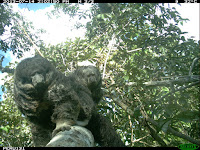 |
Abstract
Linear infrastructure development and resulting habitat fragmentation are expanding in Neotropical forests, and arboreal mammals may be disproportionately impacted by these linear habitat clearings. Maintaining canopy connectivity through preservation of connecting branches (i.e. natural canopy bridges) may help mitigate that impact. Using camera traps, we evaluated crossing rates of a pipeline right-of-way in a control area with no bridges and in a test area where 13 bridges were left by the pipeline construction company. Monitoring all canopy crossing points for a year (7,102 canopy camera nights), we confirmed bridge use by 25 mammal species from 12 families. With bridge use beginning immediately after exposure and increasing over time, use rates were over two orders of magnitude higher than on the ground. We also found a positive relationship between a bridge’s use rate and the number of species that used it, suggesting well-used bridges benefit multiple species. Data suggest bridge use may be related to a combination of bridge branch connectivity, multiple connections, connectivity to adjacent forest, and foliage cover. Given the high use rate and minimal cost, we recommend all linear infrastructure projects in forests with arboreal mammal populations include canopy bridges.
Coendou ichillus, Tamandua tetradactyla
Pithecia irrorata, Saguinus fuscicollis
Figure 1: The six species that most frequently used the 13 natural canopy bridges over the pipeline clearing:
(a) Aotus nigriceps, (b) Potos flavus, (c) Coendou ichillus, (d) Caluromys lanatus, (e) Bassaricyon alleni, and (f) Hadrosciurus spadiceus.
|
 |
| Figure 5: Tremaine Gregory climbing a canopy bridge over a recently cleared natural gas pipeline in the Lower Urubamba Region of Peru. |
Tremaine Gregory, Farah Carrasco-Rueda, Alfonso Alonso, Joseph Kolowski and Jessica L. Deichmann. 2017. Natural Canopy Bridges Effectively Mitigate Tropical Forest Fragmentation for Arboreal Mammals. Scientific Reports. 7, Article number: 3892. DOI: 10.1038/s41598-017-04112-x
Natural Canopy Bridges Maintain Vital Connections for Arboreal Mammals in Fragmented Forests NationalZoo.SI.edu/news/natural-canopy-bridges-maintain-vital-connections-for-arboreal-mammals-fragmented-forests





